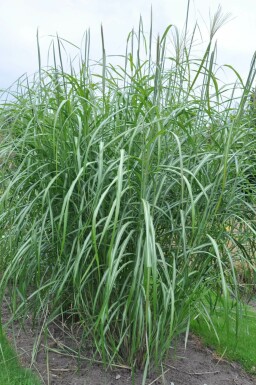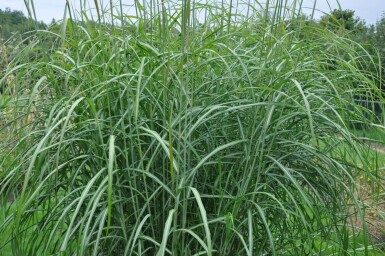





At Heijnen Plants, we take pride in offering the elegant Miscanthus, commonly referred to as silvergrass. This graceful ornamental grass is cherished for its lush green foliage and the striking array of flower colors it presents, ranging from brown to red, pink, white, and purple. While Miscanthus does not bear fruit or exude fragrance, its aesthetic appeal is undeniable. The plant's feathery plumes dance gracefully in the breeze, making it a captivating addition to any garden design, whether planted en masse for dramatic effect or used as a delicate accent in a mixed border.








150cm



















180cm





200cm














180cm





150cm






Belonging to the genus Miscanthus and commonly known as silvergrass, these ornamental grasses are favored for their elegant and statuesque appearance. Their tall, feathery plumes in a range of colors from brown to pink, and white to purple, make a striking display from late summer through fall. Miscanthus varieties offer a dynamic range of foliage colors, starting with hues of green, white, and yellow in spring, transitioning to a spectacular autumnal display of orange, brown, red, and yellow.
Miscanthus species are versatile and can be used in various landscaping applications, from elegant border plantings to striking group arrangements or as a solitary feature in a garden space. They thrive in a wide range of well-drained soil types and are adaptable to full sun or partial shade, making them a suitable choice for many gardeners. The upright to bushy growth habit of Miscanthus provides structure and texture to garden designs, while the changing foliage colors add seasonal interest.
Key characteristics include:
While Miscanthus is a hardy and low-maintenance genus, here are some tips to ensure the health and beauty of these grasses:
With their graceful form and changing colors, Miscanthus grasses are a delightful addition to any garden, offering visual interest and movement throughout the year.
Embrace the elegance of silvergrass as it sways gently in the breeze, adding a touch of serene beauty to your garden landscape. With its fine-textured foliage and graceful, arching form, Miscanthus varieties present a captivating display of movement and a soothing rustle that enriches the sensory experience of any outdoor space. Each variety brings its unique charm, with plumes that catch the light and create a silver glow that is especially enchanting during the golden hours of dawn and dusk.
We would like to provide some tips on how to plant and care for a Miscanthus. By following these tips, you can be sure to enjoy your Miscanthus for a long time.
The ideal location for Miscanthus is one where it can bask in full sun to partial shade. This plant thrives in a range of soil types, provided they are well-drained. The species exhibits its most vigorous growth and optimal flowering when exposed to ample sunlight. While it is adaptable to various lighting conditions, the vibrancy of its foliage colors and the fullness of its flower plumes are most pronounced with greater sun exposure. It is important to ensure the soil maintains adequate moisture, as Miscanthus does not exhibit drought resistance.
When planting Miscanthus, choose a location that receives full sun to partial shade to accommodate its growth preferences. The adaptable nature of this species allows it to thrive in various soil types, as long as the soil is well-drained. Planting can be done effectively throughout the year, avoiding extreme weather conditions. After positioning the pot-grown specimens in the ground, ensure they are adequately spaced to allow for their upright to bushy growth habit. Regular watering after planting is important to establish a robust root system, although once established, the plant has an average water need.
For optimal growth and development, it is advisable to fertilize Miscanthus species early in the growing season. A slow-release, balanced fertilizer applied in the spring will provide the necessary nutrients for the species' vigorous growth period. A second application can be made in early summer to support the lush foliage and the formation of the distinctive plumes that appear later in the year.
Although Miscanthus is adaptable to a variety of soil types, ensuring that the soil is well-drained and fertile will enhance its performance. Over-fertilization should be avoided, as it can lead to excessive foliage growth at the expense of the characteristic flower production. A careful balance will encourage a spectacular display of foliage and flowers from late summer into autumn.
To ensure a healthy season of growth, prune this species in late winter or early spring before the new growth starts. Cut the entire clump back to about 10-15 centimeters above the ground to make way for new shoots. This timing allows the plant's striking form to provide winter interest while protecting it from potential damage caused by harsh weather. Regular pruning encourages the plant to produce robust, fresh stems that will display the next season's foliage and flowers to their best advantage.
Miscanthus requires consistent watering, particularly during its growing season in the warmer months. While the plant's water needs are moderate, it is essential to maintain a well-hydrated environment until it has established a robust root system. Once established, it can tolerate short periods of dryness, but it is not drought resistant and should not be left to dry out completely. Watering should be done deeply rather than superficially to promote strong root growth. During periods of high heat and little rainfall, increase the frequency of watering to ensure optimal health and growth.
Miscanthus thrives with minimal care, making it an excellent choice for gardeners seeking low-maintenance yet visually striking plants. This species benefits greatly from annual mulching, which aids in moisture retention and soil temperature regulation. Furthermore, its graceful, arching form and feathery plumes add movement to the garden, creating an eye-catching display when swayed by the breeze. As a bonus, Miscanthus provides a striking visual interest in the winter landscape when other plants have receded.
To maintain the health and stimulate the growth of Miscanthus, division is recommended. This process should ideally be carried out during the cooler months of spring or autumn. Begin by lifting the plant carefully from the soil, ensuring to keep the roots intact. Once removed, divide the clump into smaller sections, each with a portion of the root system. Replant these divisions at the same depth they were growing before, allowing ample space for future expansion. This method rejuvenates the plant, promoting a more robust display of foliage and flowers in the following seasons.
Discover the enchanting beauty of Miscanthus, a versatile genus ideal for creating visually striking textures within your garden. This plant offers an elegant, feathery presence that sways gracefully with the breeze, adding a serene and dynamic aesthetic to any landscape design.
